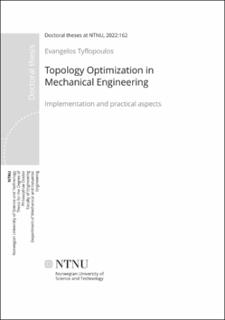| dc.contributor.advisor | Olsen, Anna | |
| dc.contributor.advisor | Torgersen, Jan | |
| dc.contributor.advisor | Steinert, Martin | |
| dc.contributor.author | Tyflopoulos, Evangelos | |
| dc.date.accessioned | 2022-05-31T07:53:55Z | |
| dc.date.available | 2022-05-31T07:53:55Z | |
| dc.date.issued | 2022 | |
| dc.identifier.isbn | 978-82-326-5408-6 | |
| dc.identifier.issn | 2703-8084 | |
| dc.identifier.uri | https://hdl.handle.net/11250/2996959 | |
| dc.description.abstract | One of the most applied optimization methods in mechanical engineering is topology optimization (TO). The benefits of its integration in the product development process are several, such as reducing material usage in manufacturing, shortening the design cycle, and enhancing product quality. However, the implementation of TO is characterized by the following bottlenecks: the geometrical complexity of its optimized designs, the long optimization times, the sensitivity of its results to the given parameters, and the need for numerous inputs during its workflow. All these issues make TO a complex and time-demanding procedure dependent on designers’ starting guesses and choices during its implementation. It is clear that there is a need for a more automatic and effective optimization procedure.
In this thesis, the author uses TO for the weight reduction of structures in mechanical engineering. First, he explores the workflow of the TO and identifies interesting practical aspects in its implementation. The most popular TO-methods, such as SIMP and BESO, are described, categorized, and compared. In addition, the three following TO-practices are developed with respect to the size of the available design space for optimization: TO with limited design space, TO with maximum possible design space, and combined size/shape/topology optimization. The author states that the designer’s choices (inputs) affect the TO-results and categorizes them into five clusters of parameters: design constraints, supports and connections, loads, geometric restrictions due to manufacturing constraints, and software constraints. The sensitivity of the TO-results to the variations of these parameters is explored.
Furthermore, different multi-objective, multi-level, and multi-scale optimization workflows are used in the pursuit of the lightest design solutions. To identify the software constraints, a literature review is conducted among the most applied TO-software platforms. As a result, an online library of 70 commercial and open source TO software is developed in the form of a table. This table encompasses the name, company, optimization types, and methods that software uses, as well as its available objective functions and constraints in TO. Moreover, relative research works and representative literature for each software are included. Different 3D models are designed, optimized, and used as case studies to support the theory and tie the academic text to real-world applications of TO. Finally, the educational perspective of TO is checked. The author developed an educational framework of a topology optimization-based learning (TOBL) combining the CDIO-approach and TO. The implementation of the developed TOBL-framework in any study program in CAD-engineering can educate modern CAD-designers to conceive, design, implement, and operate optimized products.
The current research work is addressed to practitioners, researchers, teachers, and other engineers looking for new lightweight design concepts. Hence, the aim of this thesis is to provide them, through valuable insights, with a better understanding of TO, as well as to advise them with guidelines and recommendations to avoid common pitfalls. | en_US |
| dc.language.iso | eng | en_US |
| dc.publisher | NTNU | en_US |
| dc.relation.ispartofseries | Doctoral theses at NTNU;2022:162 | |
| dc.relation.haspart | C1: Tyflopoulos, Evangelos; Flem, David Tollnes; Steinert, Martin; Olsen, Anna. State of the art of generative design and topology optimization and potential research needs. I: DS 91: Proceedings of NordDesign 2018 | en_US |
| dc.relation.haspart | C2: Tyflopoulos, Evangelos; Steinert, Martin. Messing with boundaries - quantifying the potential loss by pre-set parameters in topology optimization. Procedia CIRP 2019 ;Volum 84. s. 979-985 Tyflopoulos, Evangelos; Steinert, Martin. Messing with boundaries - quantifying the potential loss by pre-set parameters in topology optimization. Procedia CIRP 2019 ;Volum 84. s. 979-985 https://doi.org/10.1016/j.procir.2019.04.307 Attribution-NonCommercial-NoDerivatives 4.0 International (CC BY-NC-ND 4.0) | en_US |
| dc.relation.haspart | C3: Tyflopoulos, Evangelos; Steinert, Martin. A comparative study between traditional topology optimization and lattice optimization for additive manufacturing. Material Design & Processing Communications (MDPC) 2019 https://doi.org/10.1002/mdp2.128 This is an open access article under the terms of the Creative Commons Attribution License (CC BY 4.0) | en_US |
| dc.relation.haspart | C4: Tyflopoulos, Evangelos; Steinert, Martin. Topology and Parametric Optimization-Based Design Processes for Lightweight Structures. Applied Sciences 2020 ;Volum 10.(13) https://doi.org/10.3390/app10134496 This is an open access article distributed under the Creative Commons Attribution License (CC BY 4.0) | en_US |
| dc.relation.haspart | C5: Tyflopoulos, Evangelos; Lien, Mathias; Steinert, Martin. Optimization of Brake Calipers Using Topology Optimization for Additive Manufacturing. Applied Sciences 2021 ;Volum 11.(4) https://doi.org/10.3390/app11041437 This is an open access article distributed under the Creative Commons Attribution License (CC BY 4.0) | en_US |
| dc.relation.haspart | C6: Tyflopoulos, Evangelos; Hofset, Tarjei Aure; Olsen, Anna; Steinert, Martin. Simulation-based design: A case study in combining optimization methodologies for angle-ply composite laminates. Procedia CIRP 2021 ;Volum 100. s. 607-612 https://doi.org/10.1016/j.procir.2021.05.131 This is an open access article under the CC BY-NC-ND license (https://creativecommons.org/licenses/by-nc-nd/4.0) | en_US |
| dc.relation.haspart | C7: Tyflopoulos, Evangelos; Haskins, Cecilia; Steinert, Martin. Topology-Optimization-Based Learning: A Powerful Teaching and Learning Framework under the Prism of the CDIO Approach. Education Sciences 2021 ;Volum 11.(7) | en_US |
| dc.relation.haspart | C8: Tyflopoulos, Evangelos; Steinert, Martin. Combining Macro- and Mesoscale Optimization: A Case Study of the General Electric Jet Engine Bracket. Designs 2021 ;Volum 5.(4) https://doi.org/10.3390/designs5040077 This is an open access article distributed under the Creative Commons Attribution License (CC BY 4.0) | en_US |
| dc.relation.haspart | C9: Tyflopoulos, Evangelos; Steinert, Martin. A Comparative Study of the Application of Different Commercial Software for Topology Optimization. Applied Sciences 2022 ;Volum 12.(2) ( https://doi.org/10.3390/app12020611 (CC BY 4.0) | en_US |
| dc.title | Topology Optimization in Mechanical Engineering: Implementation and practical aspects | en_US |
| dc.type | Doctoral thesis | en_US |
| dc.subject.nsi | VDP::Technology: 500::Mechanical engineering: 570 | en_US |
